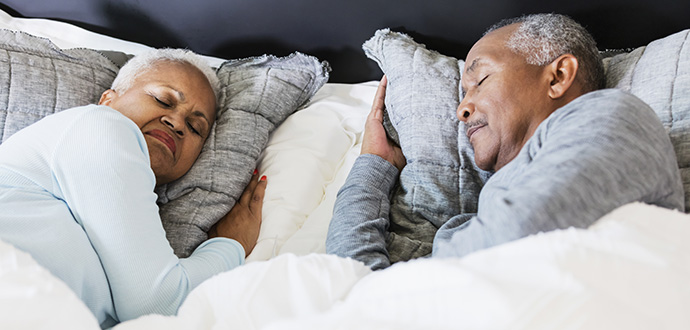
It’s easy to think of sleep as one long stretch of inactivity, but there are 5 unique stages of sleep that the human body experiences. There are a lot of things happening in the body during sleep, and these cycles are necessary to fuel the body with energy and carry out bodily processes that contribute to overall wellness.
This article describes the stages of sleep and addresses common questions, such as what is REM sleep and how long is a sleep cycle. This article also discusses how sleep cycles can change with age.
The 5 Stages of Sleep
The first stage of sleep is a period of very light sleep when a person drifts into and out of consciousness. A person is easily awakened during this stage, and muscle contractions are common. Stage two of sleep occurs when the brain waves slow down and eye movement ceases. This is also when a person’s body temperature drops and the heart rate slows down. 1
During stage three of sleep, slow and faster brain waves alternate and a period of deep sleep sets in. This is a transitional time between non-REM and REM sleep and when sleep disorders, such as sleepwalking, may occur. The fourth stage of sleep is marked by more deep sleep and slow brain waves. Finally, the last of the 5 stages of sleep is REM sleep, which is rapid eye movement sleep.1
What Is REM Sleep?
REM sleep is a time in which the brain waves are similar to those experienced while a person is awake. The eyes move quickly while still remaining closed. This is the period of sleep associated with dreaming and heightened levels of brain activity.1
How Long Is a Sleep Cycle
Although each sleep stage is unique, they typically last for similar periods of time. Each stage lasts for about five to 15 minutes in healthy adults. Therefore, a complete sleep cycle from stage one through five should last about 90 to 110 minutes. Overall, a healthy adult should get about 90 to 120 minutes of REM sleep and four to seven hours of non-REM sleep per night. However, health conditions, stress, pre-bedtime habits, and melatonin supplements to promote sleep may alter sleeping patterns and cycles.2
How Sleep Cycles Change Over Time
Interestingly, sleep cycles can change throughout the course of a person’s lifespan. Changes in sleep patterns are part of the aging process, and older adults often have a more difficult time falling asleep and staying asleep as the years go by. The total amount of REM sleep achieved also tends to decline with age, leaving seniors feeling more tired and irritable during the day.1 This may mean more time spent in non-REM sleep and having less deep sleep results in a person waking up more frequently throughout the night. Well-timed naps that allow for a full 90-minute sleep cycle can help older adults get the REM sleep they need and feel less fatigued during the waking hours.
References
- National Sleep Foundation. Understanding Sleep Cycles: What Happens While You Sleep. Retrieved December 14, 2018 from https://www.sleep.org/articles/what-happens-during-sleep/
- National Institutes of Health. Melatonin: In Depth. Retrieved December 13, 2018 from https://nccih.nih.gov/health/melatonin